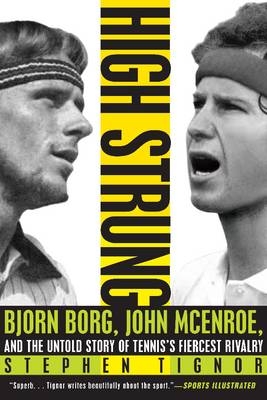
High Strung
Bjorn Borg, John McEnroe, and the Untold Story of Tennis's Fiercest Rivalry
Seiten
2012
HarperPaperbacks (Verlag)
978-0-06-200985-2 (ISBN)
HarperPaperbacks (Verlag)
978-0-06-200985-2 (ISBN)
- Titel wird leider nicht erscheinen
- Artikel merken
For nearly a century, the lawns of tennis had been reserved for wealthy amateurs-gentlemen - but in 1968, the game was opened to professionals and was forever changed. The 1970s were boom years for tennis. This book chronicles the lives and careers of the men who made those Wild West days of tennis so memorable.
The golden age of tennis came crashing down suddenly at the 1981 U.S. Open. Bjorn Borg, the stoical Swede who had become the richest and most famous player in the sport's history, had just lost to his brash young rival, John McEnroe, in the final at Flushing Meadows. After his last shot floated out, Borg walked to the net, shook McEnroe's hand in silence, and disappeared from the game he had dominated for the last decade. No one realized it at the time, but the era that Borg and the three other semifinalists at that year's Open - McEnroe, Jimmy Connors, and Vitas Gerulaitis - had helped define had also ended. For nearly a century, the lawns of tennis had been reserved for wealthy amateurs-gentlemen, in the original British parlance - but in 1968, the game was opened to professionals and was forever changed. The 1970s were boom years for tennis. Thanks to charismatic young players and dramatic matches, participation skyrocketed in the United States and brought the game to a new peak of global popularity. In the ensuing decade, the sport would be taken further from its genteel roots than anyone thought possible. Through the lens of that era's final tournament, the 1981 U.S.
Open, "High Strung" chronicles the lives and careers of the men who made those Wild West days of tennis so memorable. The Swede known as Ice Borg, who secretly harbored an inner madman. It was McEnroe, the tortured, bratty genius who was destined to slay his idol. It was Connors, the blue-collar kid who tore the cover off the ball-and the game itself-becoming a beloved antihero. It was Ilie Nastase, the Romanian clown who tested the outer limits of acceptable behavior and taste. It was Gerulaitis, the New York charmer and Studio 54 regular who was friend to them all. And Ivan Lendl, the robotic Czech who became a harbinger of tennis' high-powered future. The struggles these men shared were as compelling off the court as they were on. Some thrived, some survived, some were destroyed, but none has ever been forgotten.
The golden age of tennis came crashing down suddenly at the 1981 U.S. Open. Bjorn Borg, the stoical Swede who had become the richest and most famous player in the sport's history, had just lost to his brash young rival, John McEnroe, in the final at Flushing Meadows. After his last shot floated out, Borg walked to the net, shook McEnroe's hand in silence, and disappeared from the game he had dominated for the last decade. No one realized it at the time, but the era that Borg and the three other semifinalists at that year's Open - McEnroe, Jimmy Connors, and Vitas Gerulaitis - had helped define had also ended. For nearly a century, the lawns of tennis had been reserved for wealthy amateurs-gentlemen, in the original British parlance - but in 1968, the game was opened to professionals and was forever changed. The 1970s were boom years for tennis. Thanks to charismatic young players and dramatic matches, participation skyrocketed in the United States and brought the game to a new peak of global popularity. In the ensuing decade, the sport would be taken further from its genteel roots than anyone thought possible. Through the lens of that era's final tournament, the 1981 U.S.
Open, "High Strung" chronicles the lives and careers of the men who made those Wild West days of tennis so memorable. The Swede known as Ice Borg, who secretly harbored an inner madman. It was McEnroe, the tortured, bratty genius who was destined to slay his idol. It was Connors, the blue-collar kid who tore the cover off the ball-and the game itself-becoming a beloved antihero. It was Ilie Nastase, the Romanian clown who tested the outer limits of acceptable behavior and taste. It was Gerulaitis, the New York charmer and Studio 54 regular who was friend to them all. And Ivan Lendl, the robotic Czech who became a harbinger of tennis' high-powered future. The struggles these men shared were as compelling off the court as they were on. Some thrived, some survived, some were destroyed, but none has ever been forgotten.
Stephen Tignor is the Executive Editor of Tennis magazine. He writes a daily blog on Tennis.com, where he has written about the sport for the past twelve years.
| Verlagsort | New York |
|---|---|
| Sprache | englisch |
| Maße | 152 x 229 mm |
| Gewicht | 286 g |
| Themenwelt | Sport ► Ballsport ► Tennis |
| Geschichte ► Teilgebiete der Geschichte ► Kulturgeschichte | |
| ISBN-10 | 0-06-200985-0 / 0062009850 |
| ISBN-13 | 978-0-06-200985-2 / 9780062009852 |
| Zustand | Neuware |
| Haben Sie eine Frage zum Produkt? |
Mehr entdecken
aus dem Bereich
aus dem Bereich
das Phänomen Djokovic
Buch | Hardcover (2024)
Edel Sports (Verlag)
CHF 34,95
Warum Tennis das schönste Spiel des Lebens ist – und wie du immer …
Buch (2023)
Neuer Sportverlag / Neuer Kunstverlag
CHF 38,90


